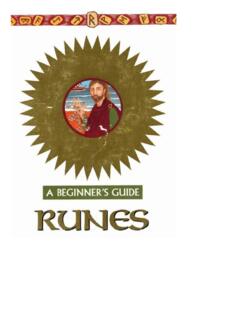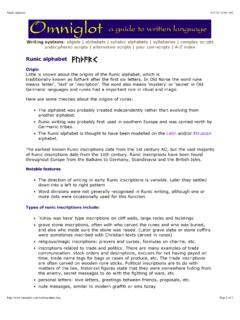Transcription of Runes - The Tolkien Society
1 The Tolkien Society 2014 1 Tolkien Society Education Packs Runes In The Hobbit Tolkien introduces his readers to the use of Runes . This pack gives some more information about the real Runes and their many uses, and suggests some entertaining ways of using them. Historical Uses Runes were a form of writing used across Northern Europe during the early Middle Ages - the time of the Anglo-Saxons and Vikings. Tolkien adapts a few of the real signs and gives a key to translating them. It is important to point out that Runes have NO connection with the occult, with witchcraft, or necessarily with paganism. They have been misused by the unwise and those who pretend to have occult powers. In reality, Runes were used to express Christian ideas and ideals as well as for more practical purposes. They were thought to have magical powers because ALL language was once thought to have magical power.
2 The power of Runes was used to protect and heal, to show devotion and to express faith in the way later forms of writing have been used to write out prayers, and set down knowledge. Two of the most famous examples of the use of Runes are both Christian in intention. The Runes on the Franks casket c. 700 AD form a border around a carving of the Coming of the Magi as well as around a carving of the myth of Weland the Smith. Here they mark the transitional stage between the pagan Norse beliefs and the conversion to Christianity. The second example is the Ruthwell Cross which was carved in the 8th century with Runes that tell part of the story of The Dream of the Rood in the Northumbrian dialect. The Dream of the Rood is a lament in the form of a poem, and it expresses the sorrow the Cross itself because it is being used for the Crucifixion of Christ.
3 The Cross itself speaks of Christ as a hero who accepts his death for the greater good. The runic alphabet was known as the futhorc from the first seven signs with which it began. Each rune had a name and it could 'mean' its name. Example: , its name was sc, meaning 'ash-tree'. It could refer to an ash-tree, or be used in a word that needed the 'a' sound we say in words like 'hat'. The rune is called 'thorn' and could be used to refer to a thorn on a plant, or as part of a word where a 'th' sound is needed. If you look at the names of the Runes you will find out a little about what was important in the Society that used them. The ash-tree was important because spear shafts were made from it. There was more than 1 futhorc and the forms of the Runes varied from country to country. These differences are reflected in the way Tolkien refers to dwarf Runes and Daeron's Runes .
4 He also used altered forms of Runes , and runic spellings that pick up these differences in the runic inscriptions on The Hobbit map. The Tolkien Society 2 The Futhorc Here is one version of the Old English futhorc. All the names of the letters are given beneath, together with what they meant. Starting from top left and listing the Runes according to their modern letters, the names of the Runes and their meanings are as follows: a - called 'ac', means 'oak' - called ' asc', means 'ash-tree' b - called 'beorc', means 'birch tree' c - called 'cen', means 'torch' d - called 'd g', means 'day' e - called 'eh', means 'horse' f - called 'feoh', means 'wealth' g - called 'gyfu', means - 'gift' (pronounced as in 'yet') g - called 'gar', means 'spear' (pronounced as in 'get') h - called 'h gl', means 'hail' (frozen rain, not a greeting) i - called 'is', means 'ice' k - called 'calc', means 'chalk' (pronounced as in 'cat') l - called 'lagu', means 'water' m - called 'man', means 'man' n - called 'nyd', means 'need'; 'affliction' the next rune is called Ing and was the name of a fertility god.
5 It has an 'ng' sound as in 'ring'; 'long'; 'fang' etc. - called 'os' we don't know what this meant p - called 'peor ' we don't know what this meant either r - called 'rad', means 'riding' s - called 'sigel', means 'sun' t - called 'tir' the name of a god, also spelt 'Tiw' from which we get Tuesday. - called 'thorn', means 'thorn' u - called 'ur', means 'aurochs' (the name of a very large form of cattle) w - called 'wynn', means 'joy' (the shape of this rune is easy to confuse with the modern 'p', and with the ' ' [thorn] rune. Note the differences: wynn is more pointed than a modern 'p', while ' ' [thorn] has a tall ascender [the bit above the bulge]. x - called 'eolhx', another rune whose meaning is unknown to us y - called 'yr', and another The Tolkien Society 3 Real Runes found in England can be of Scandinavian origin rather than being native Anglo-Saxon Runes because Anglo-Saxon England was frequently invaded and settled by Danes and other vikings.)
6 Even within Anglo-Saxon England Runes would be used according to the dialect of the region in which they were being used. So words in a runic inscription made in Wessex would be spelled differently from the same words used in a runic inscription made in Mercia or Northumbria. So translations may reveal different languages or different dialects. Runes had various functions: magical - for creating spells; practical - for sending messages; monumental - for commemorating people, actions, events decorative - Runes were used to decorate swords and rings among other things. They might spell out the name of the sword or the name of the man who owned it. But Runes used for decoration are not always translatable for the Runes themselves were seen as having magical powers. At the time when Runes were most in use all writing was considered magical to some extent because so few people could understand it (our modern word 'grammar' is related to the word 'glamour' which used to mean magic or enchantment).
7 Runes , however, may have been less obscure to ordinary people. At all times translating Runes needs great care. Runes ARE TRICKY. They were developed to be used to write short messages on wood or bone or antler - hard material, cheap and easily available - that could be scratched on. Paper was unknown in north-western Europe when Runes were being used, and parchment and vellum, made from animal hide, were very expensive and used only for very important writing such as Bibles, other religious books, and legal documents, all of which were written by hand. It is possible to write with a pen and ink on parchment and vellum, and in a cursive hand (flowing), but this cannot be done on wood, bone or antler because the material is not smooth enough, so Runes are made up of straight lines which can be cut or scratched into the surface with a knife.
8 Because of their form, Runes can easily be mistaken for simple scratches, and simple scratches may be mistaken for Runes - and embarrassing mistake for any archaeologist who tries to translate them! Just to make matters worse, runic inscriptions have been found written from right to left, and even upside down! Tolkien is clearly aware of the ease with which this mistake can happen when Aragorn consults Frodo on Weathertop, asking his opinion about some marks on a stone. Aragorn is not sure whether they are Gandalf's 'G' rune, hastily scratched on the stone, or just ordinary scratches on its surface. If you are writing Runes , remember, one wrong 'scratch' or stroke can alter the shape of the rune and change the meaning of a word. Similarly, if you are reading and translating Runes , observe every small stroke carefully. Tolkien uses Runes in The Hobbit as a phonetic alphabet , as they were originally used.
9 When people first used Runes they were designed for sounds that we no longer use, so they may look strange in translation, but give an idea of how the original language looked and sounded. The Tolkien Society 4 The map inscriptions from The Hobbit show some changes to the standard A/S runic forms, and some use of A/S spelling. If you compare the futhorc given above, you will see that Tolkien has altered some the rune shapes. Runes and Other Language Games Runes had various functions: magical - for creating spells or charms to protect or heal. practical - for sending messages; monumental - for commemorating people, actions, events decorative - Runes were used to decorate swords and rings among other things. They might spell out the name of the sword or the name of the man who owned it. Activity 1. Using Runes or plain English write a 'spell' or 'charm' to stop a water elf.
10 But first you will need to decide what a water elf is and why you might need a charm against it! (There was a real spell against a water elf.) 2. Write a spell which uses the names of plants or flowers to heal an illness or a pain. (Aragorn does this when Frodo is wounded on Weathertop in LotR) Additional information: there are many 'real' spells which date from the time of the Anglo-Saxons. They do not conflict with Christianity. They are not all written in Runes . They were used for many purposes. Some have strange names like the charm against a water elf, and the Nine Herbs Charm. This is a healing charm and very interesting because it uses herb lore as it sets nine good herbs against nine flying venoms or illnesses. The nine good herbs are: mugwort, plantain (called waybread in Anglo-Saxon), lambscress, camomile, nettle, crab apple, thyme, fennel, and attorla e (means poison's bane, but we don't know it's modern identity).


